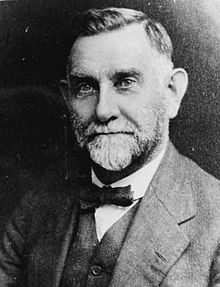Charles Chilton (zoologist)

Charles Chilton (27 September 1860 – 25 October 1929) was a New Zealand zoologist, the first rector to be appointed in Australasia,[1] and the first person to be awarded a D.Sc. degree in New Zealand.[2]
Biography
Chilton was born on 27 September 1860 at Little Marstone, Pencombe[3] (near Leominster, Herefordshire, England)[4] but emigrated with his family to New Zealand in 1862. They settled on a farm at East Eyreton, North Canterbury.[5] He was troubled by his hips from an early age, and had his left leg amputated, using an artificial leg and a crutch thereafter.[2]
He entered Canterbury College in 1875 as an unmatriculated student, and matriculated three years later. In 1881, he gained a Master of Art with first class honours, having been taught by Frederick Wollaston Hutton, who inspired him to take up biology, especially the study of crustaceans, which had been little studied in New Zealand up to that time.[4] Chilton's first scientific publication followed that same year, when he described three new species of crustacean (two crabs and one isopod) from Lyttelton Harbour and Lake Pupuke.[6] He surprised the scientific world later that year by describing four species of amphipod and isopod from groundwaters at the family farm in Eyreton.[7][8] He went on to discover the isopod Phreatoicus typicus in the same location,[9] the first example ever described of the suborder Phreatoicidea,[7] the "earliest derived isopod[s]".[10]
Chilton gained the first BSc degree from the University of New Zealand in 1887,[4] and married in 1888.[3] In 1893, he gained the first D.Sc. awarded in New Zealand, but in 1895, the family moved to Edinburgh, where Chilton studied medicine in an attempt to improve his career. He specialised in ophthalmic surgery, working at The Royal Infirmary of Edinburgh, before travelling to study at Heidelberg, Vienna and London in 1900. In 1901, he returned to New Zealand and in 1903 took on the Chair of Biology at the University of Canterbury. From 1904 to 1911, the Chilton family lived at Llanmaes, a house built by Francis Petre in central Christchurch.[1]
In 1907 Chilton was selected to be a member of the 1907 Sub-Antarctic Islands Scientific Expedition. The main aim of the expedition was to extend the magnetic survey of New Zealand by investigating Auckland and Campbell Islands but botanical, biological and zoological surveys were also conducted. The voyage also resulted in rescue of the castaways of the shipwreck the Dundonald in the Auckland Islands.[11]
In 1915, Frank Chilton, the couple's only child, a second-year medical student and a lieutenant in the Argyll and Sutherland Highlanders, was killed in the Battle of Gallipoli.[5]
Charles Chilton became rector of Christchurch University College in 1921, the first time such a post had been granted in Australia or New Zealand.[3]
Chilton died on 25 October 1929 of a sudden attack of pneumonia, before he could collect his life's work into a single monograph.[3] He had published 130 papers on crustaceans, mostly amphipods, isopods and decapods, from all around the world, but especially from New Zealand, subterranean and sub-Antarctic waters.[3]
See also
- List of New Zealand scientists
- Paraleptamphopus, a genus of groundwater amphipods discovered by Chilton
References
- ↑ 1.0 1.1 "Arts Centre of Christchurch Old Student Union Building (University of Canterbury Former)". Register of Historic Places. Heritage New Zealand. Retrieved 2009-12-01.
- ↑ 2.0 2.1 Rebecca Priestley. "Charles Chilton". National Library of New Zealand. Retrieved 22 August 2007.
- ↑ 3.0 3.1 3.2 3.3 3.4 R. L. C. Pilgrim. "Chilton, Charles 1860 – 1929". Dictionary of New Zealand Biography. Retrieved 22 August 2007.
- ↑ 4.0 4.1 4.2 George M. Thomson (1930). "Obituary: Charles Chilton 1860–1929". Transactions and Proceedings of the Royal Society of New Zealand 60: 584–587.
- ↑ 5.0 5.1 George Ranald Macdonald (1966). "Chilton, Charles (1860–1929)". An Encyclopaedia of New Zealand.
- ↑ Charles Chilton (1881). "Additions to New Zealand Crustacea". Transactions and Proceedings of the Royal Society of New Zealand 14 (XXIV): 171–174.
- ↑ 7.0 7.1 Graham Fenwick & Mike Scarsbrook (2002). "The rich biodiversity in our groundwater". Aquatic Biodiversity & Biosecurity Update (2): 2–3.
- ↑ Charles Chilton (1881). "On some subterranean Crustacea". Transactions and Proceedings of the Royal Society of New Zealand 14 (XXV): 174–180.
- ↑ Charles Chilton (1882). "Notes on, and a new species of subterranean Crustacea". Transactions and Proceedings of the Royal Society of New Zealand 15 (III): 87–92.
- ↑ J. W. Martin & G. E. Davis (2001). An Updated Classification of the Recent Crustacea (PDF). Natural History Museum of Los Angeles County. pp. 132 pp.
- ↑ E. J. Godley (1979). "The 1907 expedition to the Auckland and Campbell Islands, and an unpublished report by B. C. Aston". Tuatara 23 (3): 133–157.
- ↑ "Author Query for 'Chilton'". International Plant Names Index.
External links
 Media related to Charles Chilton (zoologist) at Wikimedia Commons
Media related to Charles Chilton (zoologist) at Wikimedia Commons
|